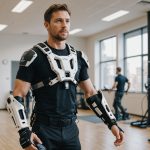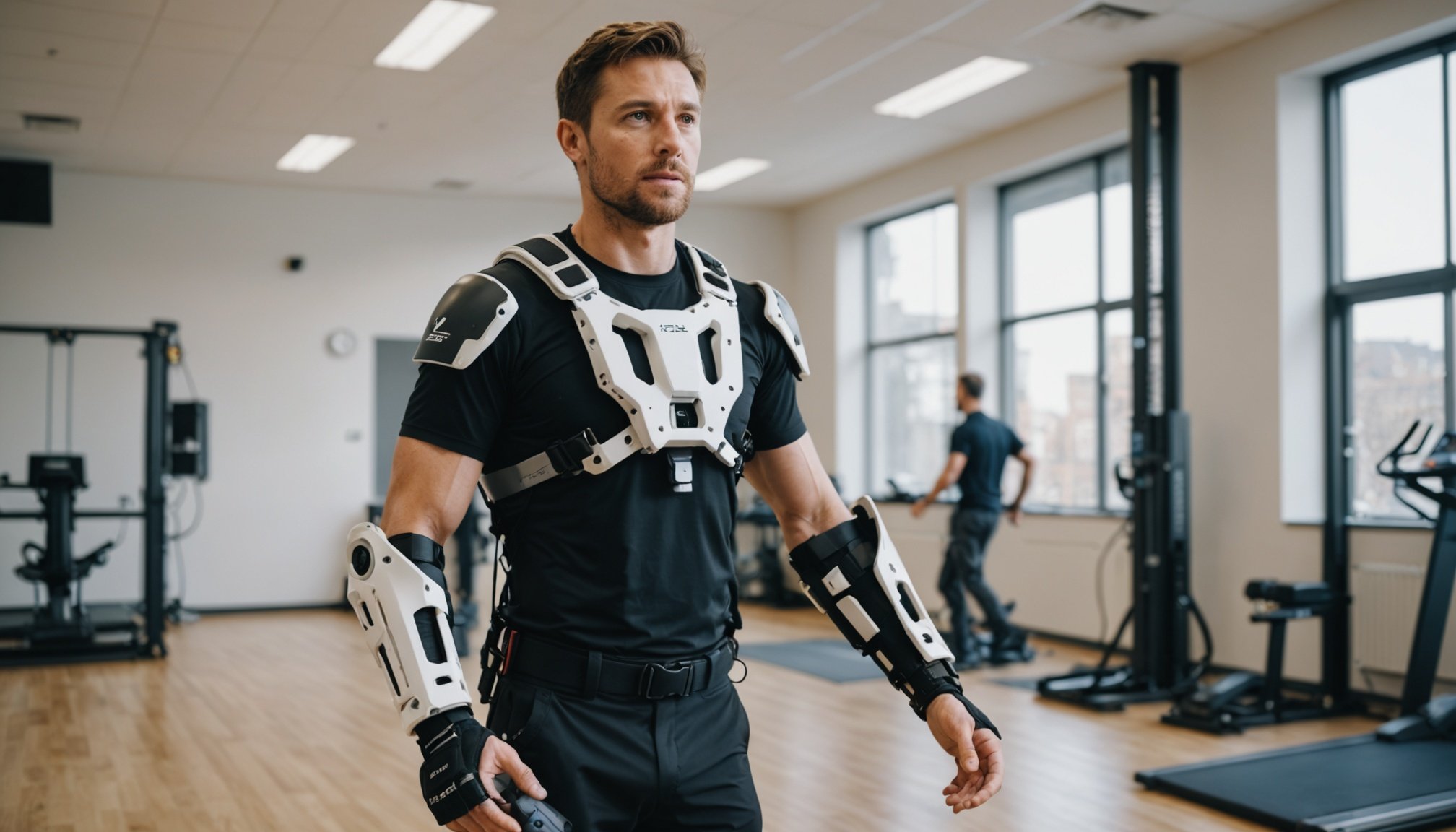Overview of Exoskeleton Technology
Exoskeleton technology represents a transformative shift in the way we approach rehabilitation and recovery. These advanced wearable devices are designed to support and enhance human movement, particularly for individuals recovering from injuries or those who require robotic rehabilitation due to physical limitations. Built with lightweight materials and sophisticated control systems, exoskeletons assist in movements such as walking, significantly improving mobility for users.
The evolution of exoskeletons has been remarkable, with rapid advancements seen in recent years. Originally conceived as military applications, these devices have found profound utility in therapeutic settings, particularly in sports injury recovery where precision and support are critical. Today’s exoskeletons are precise, responsive, and capable of handling a vast range of rehabilitation tasks, offering significant advancements over earlier robotic rehabilitation devices.
In parallel : Elevate your game: how hydrotherapy enhances recovery and performance for elite boxers
In modern rehabilitation practices, the importance of exoskeletons cannot be overstated. They provide a robust platform for aiding recovery, especially for athletes seeking to regain functionality swiftly. By incorporating precise sensors and adaptive technologies, exoskeletons facilitate a tailored rehabilitative experience, promoting efficient healing and long-term wellness. As such, they form an essential component of contemporary therapeutic strategies, delivering consistent support and optimizing rehabilitation outcomes.
Case Studies and Examples
Within the realm of exoskeleton case studies, numerous real-world applications have illustrated the potential of this technology. Specifically, we find compelling examples in the realm of high-profile athlete recoveries, where exoskeletons have significantly contributed to expedited healing timelines. Notable sports figures have turned to exoskeletons, leveraging their precision for targeted rehabilitation in sports like football and basketball. By promoting consistent movement patterns, athletes achieve optimal recovery outcomes.
In parallel : Maximizing athletic potential: how ongoing heart monitoring uncovers signs of overtraining
High-profile Athlete Recoveries
High-profile athletes recovering from severe injuries have successfully integrated exoskeleton technology into their recovery plans. This approach not only ensures faster healing but also fosters confidence in resuming athletic activities.
Rehabilitation Facilities Implementing Exoskeletons
Moreover, state-of-the-art rehabilitation facilities adopting exoskeletons indicate a shift toward technology-driven therapy options. For instance, renowned centers have integrated these devices, enabling more comprehensive patient care plans and enhancing overall therapy practices.
Quantitative Outcomes from Exoskeleton Use
Quantitative analyses reveal enhanced recovery times and success rates with exoskeleton use compared to traditional rehabilitation methods. Such evidence strongly supports the continued adoption of these technologies, illustrating their capability to revolutionize contemporary rehabilitation applications and elevate athlete recovery processes. These case studies exemplify the profound impact and promise exoskeletons hold in modern rehabilitation landscapes.
Benefits of Exoskeleton Technology Over Traditional Rehabilitation Methods
Exoskeleton technology offers distinct advantages over traditional rehabilitation methods, particularly in enhancing mobility and support. These advanced devices significantly reduce recovery times, allowing injured athletes to return to activity faster. Unlike conventional therapy, exoskeletons provide precise movement guidance, enhancing the effectiveness of each session and optimising recovery outcomes.
The integration of exoskeletons in rehabilitation therapy has revolutionised the approach to therapy effectiveness. By supporting natural movement patterns, these wearable devices minimise the strain on recovering muscles, encouraging efficient healing and fostering long-term wellness. The reduction in the number of required therapy sessions not only enhances patient satisfaction but also alleviates the overall burden on healthcare systems.
In addition to physiological benefits, exoskeletons offer notable psychological advantages. Advanced rehabilitation technologies can boost a patient’s confidence and motivation, aiding their mental recovery alongside physical healing. Patients are often more engaged when treatment incorporates cutting-edge technology, leading to improved adherence to rehabilitation protocols.
The shared expertise and collaboration among technology developers and healthcare professionals continue to drive the advancement of exoskeleton technology. Such synergy ensures these devices remain at the forefront of therapeutic innovation, providing comprehensive solutions tailored to individual recovery needs.
Applications of Exoskeleton Technology in Sports Injury Recovery
Exoskeleton technology is rapidly becoming a cornerstone in sports rehab technology, marking a paradigm shift in rehabilitation applications. These innovations offer strategic enhancements to athlete recovery, especially in sports involving high physical stress like football, basketball, and running.
The integration of exoskeletons in physical therapy environments underscores their potential in accelerating recovery processes. By mimicking natural movement patterns, these devices cater to various injury types, facilitating effective rehabilitation. Emphasizing precision, exoskeleton technology ensures targeted therapy, significantly benefiting injuries such as ACL tears or shoulder dislocations.
Collaboration between technology developers and rehabilitation centers is pivotal for advancing this integration. This partnership results in tailor-made solutions, optimising the use of exoskeletons for individual recovery needs. Renowned centers are actively adopting these technologies, further validating their efficacy in sports rehabilitation.
Through these advancements, athletes experience enhanced recovery journeys. The tailored support minimizes downtime, allowing a safer return to sporting activities. As such, exoskeleton technology represents a vital tool in the modern sports rehabilitation toolkit, championing both innovation and efficacy in athlete recovery.
Expert Insights and Perspectives
Understanding the viewpoints of rehabilitation experts is crucial to appreciating the full potential of exoskeleton technology in sports recovery. Leading experts in the field frequently highlight the transformative nature of these devices. They emphasize how industry insights are shaping future rehabilitation environments, particularly concerning the integration of advanced technology with traditional practices.
Experts anticipate that exoskeletons will play a pivotal role, enhancing techniques and offering more personalized rehabilitation experiences. This infusion of technology not only accelerates recovery but also shifts the paradigm of sports injury treatment. They foresee a future where exoskeletons, combined with other innovations, streamline rehabilitation protocols, ensuring precision in injury-specific therapies.
Interviews with professionals reveal a frequent consensus on the ethical considerations and the necessity for professional opinions in guiding the implementation of these technologies. Recommendations often focus on balancing technological advancements with patient-centric care, ensuring best practices are adopted.
Furthermore, experts predict that as exoskeleton technology evolves, it will demand better training and collaboration between rehabilitation experts and technology developers. This synergy ensures these devices fit seamlessly into rehabilitation programs, thereby optimizing recovery strategies and enhancing patient outcomes.
Impact on Physical Therapy Practices
Exoskeleton technology is driving notable shifts in physical therapy evolution, shaping how rehabilitation practices are executed. These advanced devices have prompted significant changes in therapy protocols, ensuring exercises are more efficient and tailored to individual recovery needs. With the introduction of robotic devices, therapists have observed quicker progress in patients due to the precision and support provided by these technologies.
The integration of exoskeletons brings a necessity for additional training for physical therapists. This focuses on understanding device mechanics, adaptability, and managing therapy sessions incorporating these devices. By upskilling in these areas, therapists can optimize the use of exoskeletons, ensuring patients receive holistic, effective rehabilitation.
Moreover, the psychological impact of utilizing advanced technology boosts patient engagement and motivation. Patients are often more enthusiastic about their therapy sessions, experiencing a sense of empowerment through controlled and supportive rehabilitation techniques. This enhanced motivation is crucial for maintaining consistent progress and achieving long-term recovery goals.
As rehabilitation practices continue to adapt, the role of exoskeletons will likely expand, heralding a new era of patient-centered care driven by state-of-the-art technology.
Future Trends in Rehabilitation Technology
In considering the future of rehabilitation, constant innovation is pivotal. Emerging technologies that complement exoskeletons promise revolutionary changes in sports recovery. State-of-the-art innovations, such as biofeedback systems and AI-driven analytics, are being integrated with exoskeletons, enhancing real-time monitoring and personalized therapy adjustments.
Upcoming trends indicate a shift towards more immersive rehabilitation, where virtual reality (VR) environments simulate real-world conditions. This can significantly benefit athlete recovery, allowing sports-specific scenarios to aid rehabilitation. Additionally, wearable sensors are poised to advance data collection, providing detailed insights into patient progress and tailoring recovery protocols.
Research and development are crucial in driving these innovations. Organizations are pouring resources into optimizing robotic rehabilitation to ensure these technologies meet diverse recovery needs effectively. Collaborative efforts between technology developers and sports medicine professionals are key in crafting versatile and impactful rehab solutions.
Ultimately, the trajectory of rehabilitation technology underscores a future where integration of emerging tools alongside exoskeletons enhance recovery efficiency and outcomes. Athletes will likely experience more dynamic and interactive rehabilitation processes, heralding a new era of innovative rehab solutions tailored to their specific recovery journeys.











